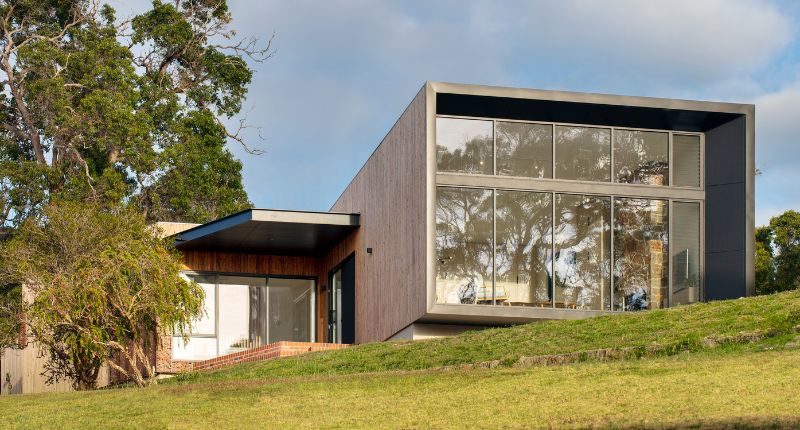- Sustainability is key, with the property not needing air con or heating
- Nods to the client's story feature throughout the property
- Designed by PTX Architects
Inlet Drive Residence by PTX Architects is situated on a picturesque site, the owner drawn to the location by strong emotions linked to memories of holidays spent fishing in a tinnie on the Wilson Inlet with his father.
A long, narrow block with an east-west orientation trailing down to the inlet, along with planning restrictions on setbacks, presented challenges for David Gibson and Melanie Hoessle, co-founders of PTX Architects.
However, obstacles were overcome with clever, thoughtful design, resulting in unanimous council approval and incredibly happy clients.
A 1950s house and an old weatherboard fishing shack were originally on the site. The orientation of the original house didn’t allow for passive solar gain in winter so this was demolished, but the fishing shack remains.
“Before we began planning, we sat on-site with our clients, Peter Somerford and Giulia Maranta, to tease out memories of why they were so attached to the location,” David said.
“Marrying that information with our understanding of the block, we constructed an overarching concept.”
David and Melanie were keen to honour the reason the client bought the property, those wonderful memories of holidays Peter spent fishing on the inlet with his dad.
“We quickly landed on inspiration taken from the local environment – granite boulders lying in the water at the base of the site,” said David. “The client identified with our notion and loved it from the outset.”
The design of the new 190 square metre home resembles a series of long formed boulders. Comprised of three interconnecting spaces, each form is orientated differently, capturing extensive inlet and vegetated garden views. The forms are connected by an east to west concrete spine wall.
The long driveway delivers you to the first form, a weathered timber clad garage. The second form houses three bedrooms, two bathrooms and a powder room. The final form presents a sweeping open-plan living, kitchen and dining space, featuring a double-volume wall of high-performance glazing showcasing the spectacular inlet view.
The granite boulders also inspired the materials used and colours reference those from the natural site. David and Melanie selected raw materials such as weathered timber cladding, reddish moss Corten, concrete flooring, and concrete for the spinal wall and retaining walls, all working in balance with the environment.
David and Melanie engaged a local artist to create something special, resulting in a series of rocks embedded in the spinal wall, adding to the uniqueness of the elegant design.
Sustainability is key to the home with clever design negating the need for air conditioning or heating. Automated louvred window sections at either end of the house cool the forms quickly in summer, while the thermal mass of the concrete spine controls the internal temperature in winter.
A solar panel energy system and an efficient heat pump hot water system are also employed. A large sliding perforated glazing and Corten steel panel is opened in winter and closed in summer. David notes, “The clients are happy to put on a jumper if they feel cold but the home performs well without heating or cooling… there is a fireplace, but it’s really for ambience.”
Client and architects together selected furniture to suit the space and feel of the home. One unique piece is an 80-year-old concrete laundry trough which was removed from the fishing shack and placed in the service nook outside the laundry.
This is where Peter cleans the fresh fish he catches from the inlet at the bottom of his property – another thoughtful design ode to the location, which holds the client’s precious childhood memories.
~~
Written by Amber Sheldon. Photography by Bo Wong.
This story was originally published in The Architect magazine, an official publication of the Australian Institute of Architects. It has been edited for republication by The Property Tribune.
The Property Tribune thanks the Australian Institute of Architects for the opportunity to republish the work, and shine a light on Australian architecture.




























